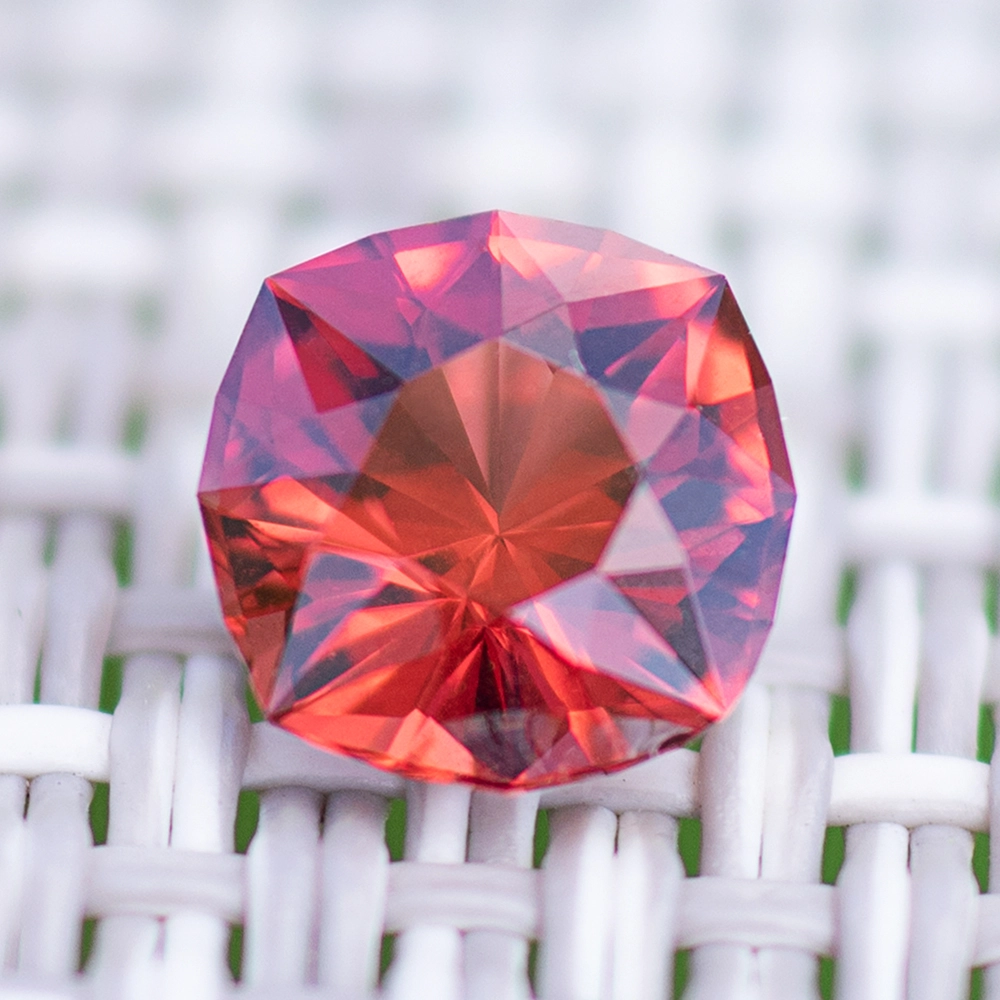
Rhodolite Garnet
A 1 carat cranberry colored rhodolite garnet, cut by us in a modified cushion cut.
The Wonderful World Of Garnet
Did you know that garnet comes in more colors than the classic red that most people associate it with? Some of the most stunning greens, yellows, oranges, pinks, purples, and reds can be seen in different types of garnet, with some shades being unique and rare.
With member names such as pyrope, almandine, and spessartine, things can get confusing fast! So, let’s take a look at some of the less known and more valuable garnet varieties, as well as some of the history and lore surrounding this diverse group.
Green Garnet
Demantoid garnet & tsavorite garnet
DEMANTOID
Both of the green varieties of garnet are rare, with demantoid being particularly so. In fact, demantoid is the most expensive garnet variety, and is among the world’s most valuable gemstones. It’s value is due to its rarity and brilliance, which is also what helped name it: the word demantoid is derived from German, which means roughly “similar to diamond”. It was demantoid’s diamond-like lustre and scintillation that inspired its naming by the same man who identified alexandrite; the first color-change gemstone!
Demantoid’s brilliance is due to its relatively high index of refraction (the amount that light bends when entering the stone), and its very high level of dispersion (the degree to which white light is broken up into spectral colors). While the effects of dispersion are more subdued in colored gemstones, demantoid’s dispersion is so high (it even surpasses that of diamond’s!) that colored flashes can be seen quite strikingly. Speaking of color, demantoid varies from a slight yellowish green, to a brownish green, with vivid emerald-like tones being the most valuable.
Demantoid was first discovered in the mid 1800’s in the Ural Mountains of Russia. It quickly rose to prominence throughout the world, being displayed in the jewelry of New York, Paris, and St Petersburg. For more than a century the supply of demantoid was limited to the Russian find, but today it can be found in numerous countries including Namibia, Iran, Madagascar, and Italy.
One last thing to say about demantoid before moving on. The Russian type often contains “horsetail” inclusions, named after their horsetail-like appearance. While inclusions usually decrease the value of a gem, in this case, they can actually increase it. This is because this type of inclusion is almost always found in Russian demantoid, which is the most highly sought after, and usually acts as a positive identifier of Russian demantoid.
TSAVORITE GARNET
Not to be outdone by its green cousin demantoid, tsavorite is another beautifully colored green garnet. Although it doesn’t have quite the high degree of dispersion as its cousin, its fresh green color makes for a truly remarkable gemstone. While quite rare in larger sizes, and therefore more costly, smaller gem quality tsavorite isn’t nearly as hard to find. Like demantoid, the most prized color is a deeply saturated emerald-like green.
Tsavorite was discovered in the 1960’s by a geologist named Campbell R. Bridges. It is named after the Tsavo West National Park conservation area in Kenya, close to where the first commercially viable gemstones were mined. It wasn’t until 1975, when Tiffany & Co. popularized it with a marketing campaign, that it reached worldwide recognition.
Orange Garnet
Mandarin garnet
Garnet can be found in varying shades of orange, with value directly linked to clarity and purity of color. The most desirable are known as mandarin garnets (sometimes referred to as fanta garnets), which have a unique intensity and a pure orange hue. Orange garnets can be found in numerous countries around the world, but the pure orange of mandarin garnet is usually found in just two: Namibia and Nigeria.
Like the other garnet varieties, mandarin garnet has good optical properties, with a particularly high refractive index. This means that mandarin garnet has a high degree of brilliance, returning much of the light that enters the stone back to the viewer’s eye.
Yellow Garnet
Topazolite & Mali garnet
There are a number of different garnet varieties that display yellowish undertones, but topazolite and Mali garnet stick out for their color. Both can display rich shades of yellow-green to a more pure lemon yellow, and both are rare varieties.
Topazolite is similar to demantoid garnet in that they’re both varieties of andradite; their difference is simply one of color. Unfortunately for topazolite – which can produce beautiful and unique colors in its own right – it is usually heat treated with low temperature in order to drive out the yellowish color. This has the effect of creating a more demantoid-like green, and therefore a more expensive stone.
Mali garnet is a relative newcomer in the gemstone world. It was discovered in the Republic of Mali in 1994, and quickly rose to prominence. In recent years, smaller amounts have been produced. Mali garnet could also have been listed with the green garnets, because of the striking and very rare chrome-green color that is sometimes seen. The Republic of Mali is still the only country known to produce this garnet type.
Purplish Pink Garnet
Rhodolite garnet
Rhodolite is a garnet variety that is valued for its purplish-red to reddish-pink color. Like other garnets, it displays a good amount of brilliance because of its relatively high refractive index. The name rhodolite is derived from the Greek word “rhodon”, which means “rose-like’.
Rhodolite is the most common of the rare garnet types, and is therefore not as costly as the above mentioned stones. Unlike many other types of gemstone, rhodolite is rarely treated or enhanced. This is a plus for gemstone owners or enthusiasts who are seeking a genuinely natural stone. Another plus is they are very often found “clean”, which means they lack inclusions and blemishes.
Even though pyrope garnet is the classic deep red birthstone of January, rhodolite is sometimes used as a substitute. This can be a nice change, not only because some purplish or pink undertones are added, but also because rhodolite tends to be less color saturated than pyrope, which can have a positive affect on brilliance.
Rhodolite can be found in Mozambique, Madagascar, Malawi, Tanzania, the United States, Brazil, India, Sri Lanka, and Norway.
History & Lore
Garnet has adorned jewelry for millennia, and is undoubtedly one of the first gemstones used by people. It has maintained a place of prominence through time, with powerful patrons including pharaohs, emperors, empresses, clergy and aristocracy. It should come as no surprise, then, that numerous myths, ancient lore, and stories are associated with garnet – particularly the deep red pyrope member.
A look back through the ages reveals:
- The word garnet comes from the Latin word granatum, meaning “pomegranate”. The seeds of the pomegranate in particular are garnet-red.
- In the Jewish Talmud, a radiant garnet guided Noah’s Ark through the endless rains.
- It is believed that one of the gemstones given to King Solomon by God was a garnet.
- In the old testament, the High Priest Aaron wore a breastplate of twelve gemstones, one of which was a carbuncle (i.e., a garnet).
- Ancient Romans used garnet to carve intaglios, which were used in signet rings. They were also the most commonly used gemstone in the Late Antique Roman world.
- The Greek philosopher Plato had his portrait engraved on a garnet.
- Garnet was used as a magical stone capable of healing the bearer from a wide variety of ailments and diseases.
- It was used for centuries as a stone of protection. Travelers and explorers carried garnet as protection on journeys, while warriors and crusaders set it in their armor, shields, and buckles as protection against wounds and bleeding.
The number of stories and myths surrounding this lovely gemstone is truly staggering. Medieval lapidary texts (as per wikipedia: lapidary is a text, often a whole book, giving “information about the properties and virtues of precious and semi-precious stones”) alone could fill up pages on the religious, magical, and healing properties of garnet.

